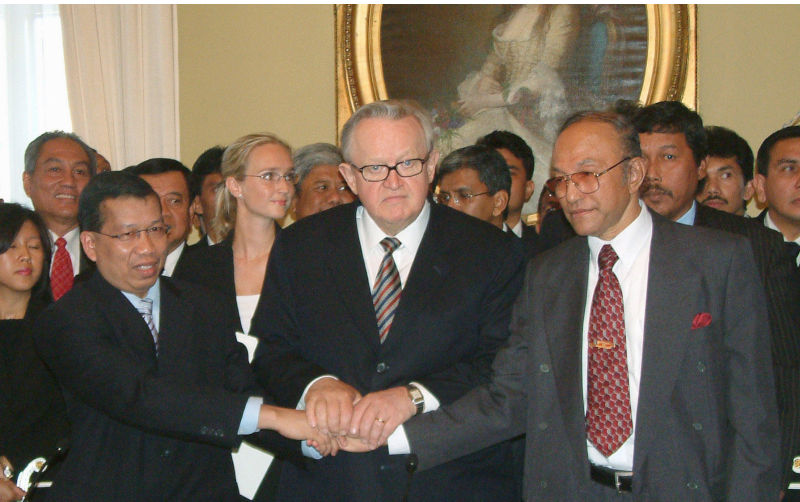Lessons from Aceh's peace agreement
August 11, 2025
This 15 August marks the 20th anniversary of the signing of the Aceh peace agreement which ended three decades of separatist war in Indonesia’s western-most province.
The agreement, known as the Memorandum of Understanding, has been notable for two qualities, the first of which has been that, unlike many peace agreements which eventually collapse, the MOU has held intact.
The MOU’s second quality comes from the lessons it has provided for other conflict resolution processes. The first rule of negotiations is that if war is politics by other means, then negotiations to end war are intensely political, for each with their domestic constituencies as well as between negotiating parties.
The second rule of conflict resolution is that the parties to the conflict have to want the conflict to end. In Ukraine and the Gaza Strip, at least one of the parties is uninterested in genuinely negotiating at this time.
Similarly, there were a number of sets of talks in Sri Lanka’s war with the Tamil Tigers, but they lacked political commitment from both sides. This resulted in the government eventually crushing the Tamil Tigers, with some 40,000 civilians being killed in the final weeks of its campaign – an alternative lesson that appears to have resonated elsewhere.
What makes a conflict “ripe” for a negotiated resolution is when neither side can decisively defeat the other and that the cost of continuing war for both parties exceeds any possible benefits. This is referred to as a “hurting stalemate”.
In the Philippines island of Mindanao, the long-running separatist with the Moro Islamic Liberation Front was unable to be militarily won by either side yet continued to drain people and resources from both, pushing both sides towards peace. So, too, Colombia’s revolutionary war ended when, after 50 years, neither side could make headway, as was also the case in El Salvador’s civil war. In the border clashes between nuclear armed India and Pakistan, both sides agreed to end fighting, recognising that should one side prevail over the other, the losing party would likely resort to nuclear weapons, creating a stalemate of a different type.
Other factors contributing to successful negotiations may include changes in political leadership where there is less commitment to war’s original goals (the Ukraine war would likely end in genuine negotiations if Vladmir Putin left the political stage); where original goals have been lost in the “fog of war”; where natural disasters introduce new, compelling priorities such as the 2004 Indian Ocean tsunami; and where there is external intervention or pressure by other states or groups of states.
External parties can also offer inducements to cease fighting, such as reconstruction, aid and investment and can also act as neutral mediators in a negotiation process, such as Qatar in the Gaza war, as well as being guarantors that any agreement reached will be honoured.
A key problem with peace negotiations is that not everyone wants to see them succeed; most negotiations have such “spoilers”. It is therefore critical that for negotiations to succeed, both parties must have a political monopoly on their own side, including an ability to neutralise spoilers.
Where conflict is over a territory within a state, for example, the Donbas region of Ukraine, or effective state control, such as the Palestinian territories, there may need to be agreement for the legalisation of banned political parties and the creation of autonomous, effectively self-governing, regions within the overarching state.
Assuming agreement can be achieved, the basic methods of implementation are through sequenced transitional arrangements, or through everything at once. The problem with the former is that it allows numerous points at which implementation of an agreement can fail; the problem with the latter is that managing all aspects of an agreement at the same time can overwhelm organisational capacity.
Beyond this, negotiations are not about each side getting everything they want, but about what they can live with. It is also helpful if each side thinks not about their public claims, but what of substance they need and then working towards that. In the end, 50% of something is always better than 100% of nothing.
If both sides can find genuine points of agreement, each side may be able to increase the benefit of peace beyond a mere half. In this way, the totality of a good agreement can, in a functional sense, be greater than the sum of its parts.
But even with everything in favour, negotiations to permanently end war are nothing if not exceptionally complex, multi-layered processes involving many moving parts which, in turn, are inherently prone to failure. It is only with compelling circumstances and commitment to finding an outcome, carefully managed by both sides as well as the mediator, that success can be achieved.
It remains instructive that, after six months of talks, the Aceh peace agreement was only finally achieved with a skilled mediator and both parties making real compromises.
The views expressed in this article may or may not reflect those of Pearls and Irritations.

